 |
  Home | Contact | Site Map |

| Top Destinations |
|
You are here Home » Top Destinations » Sikkim East India
Honeymoon in Sikkim, East India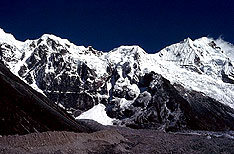 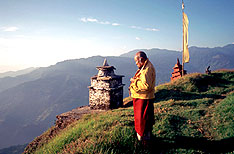 About Sikkim A journey to Sikkim necessarily means awakening the senses and discovering the pristine and mystic beauty of the land. What one will find most fascinating is the journey itself-a continuum of sights, sounds, and feelings. Sikkim is a dream that one can realize and enjoy, now that the area is open to all. It is a state cloaked in the mystery of remoteness, and far away from the din and bustle of the modern world. Located in the eastern Himalayas, Sikkim is bound by Tibet (China) in the north, West Bengal in the south, Tibet and Bhutan in the east and Nepal in the west. The state is spread below Mount Kanchanjunga (8,534 m), the third highest peak in the world. The locals worship the mountain as a protecting deity. The elevation of the state ranges between 300 m and over 8,500 m above sea level. A part of the lesser, central, and Tethys Himalaya; Sikkim is a mountainous state without any significant flat land. The larger part of the state is made up of Precambrian rock and is comparatively younger than the Northern, Eastern and Western portion of the state. The rise of the mountains is northward. The state is cut into steep escarpments in the north and except in the Lachung and Lachen valleys, is thinly populated. In contrast to Northern Sikkim is Southern Sikkim, which is lower, more open, and fairly well cultivated. The drainage of the rivers in the state is towards south. The Rangeet and the Teesta are the major river systems of state. These rivers cut through the valleys and in addition there are 180 perennial lakes at different altitudes. The state has many hot water springs like Phur-Cha, Ralang Sachu, Yumthang, and Momay. The snowline starts at around 5,248 m in Sikkim. HISTORYBuddhism, the major religion in the state, arrived from Tibet in the 13th century. It took its distinctive Sikkimese form four centuries later, when three Tibetan monks of the old Nyingamapa order, dissatisfied with the rise of the reformist Gelukpas, migrated to Yoksum in western Sikkim. Having consulted an oracle, they went to Gangtok looking for a certain Phuntsong Namgyal, whom they crowned as the first Chogyal or 'Righteous King' of Denzong in 1642. Being the secular and religious head, he was soon recognized by Tibet, and brought sweeping reforms. His kingdom was far larger than today's Sikkim and included Kalimpong and parts of western Bhutan. Over the centuries, the territory was lost to the Bhutanese, the Nepalese and the British. The British policy to diminish the strong Tibetan influence resulted in the import of workers from Nepal to work in the tea plantations of Sikkim, Darjeeling and Kalimpong and these soon outnumbered the indigenous population. After India's Independence, the eleventh Chogyal, Tashi Namgyal, strove hard to prevent the dissolution of his kingdom. Officially, Sikkim was a protectorate of India, and the role of India became increasingly crucial with the Chinese military build-up along the northern borders that culminated in an actual invasion early in the 1960s. The next king Palden Thondup was a weak ruler and in 1975, succumbed to the demands of the Nepalese majority of becoming a part of India. PEOPLE AND CULTUREIt is traditionally accepted that the Lepchas are the autochthonous tribe of Sikkim. After them came the Bhutias, from Tibet, followed by the Nepalese and finally the Indian business community from the plains. However, before one goes into the ethnic composition of Sikkim, it needs to be said that the Sikkimese, irrespective of the tribe, class or community they belong to , are essentially simple folk. Like most hill-tribes, the Sikkimese are thus far relatively untouched by consumerism. Cliched though it may sound, the Sikkimese truly exemplify how different communities can exemplify how different communities can coexist in peace and mutual. THE LEPCHASThe original inhabitants of Sikkim are said to be Lepchas. They existed much before the Bhutias and Nepalese migrated to the state. Before adopting Buddhism or Christianity as their religion, the earliest Lepcha settlers were believers in the bone faith or mune faith. This faith was basically based on spirits, good and bad. They worshipped spirits of mountains , rivers and forests which was but natural for a tribe that co-existed so harmoniously with the rich natural surroundings. The Lepcha (Zongu) folklore is rich with stories. The Lepcha population is concentrated in the central part of the Sikkim. This is the area that encompasses the confluence of Lachen and Lachung rivers and Dickchu. THE NEPALESEThe Nepalese appeared on the Sikkim scene much after the Lepchas & Bhutias. They migrated in large numbers and soon became the dominant community. The Nepalese now constitute more than 80 % of the total population. The Nepali settlers introduced the terraced system of cultivation. Cardamom was an important cash crop introduced by the Nepalese. Except for the Sherpas & Tamangs who are Buddhists, the Nepalese are orthodox Hindus with the usual caste system. THE BHUTIASThey are the people of Tibetan origin. They migrated to Sikkim perhaps somewhere after the fifteenth century through the state of Sikkim. In Northern Sikkim, where they are the major inhabitants, they are known as the Lachenpas and Lachungpas. The language spoken by the bhutias is Sikkimese . Bhutia villages are as large as those compared to those of Lepchas. A Bhutia house called "Khin" is usually of rectangular shape. FOODSikkim has its own unique dietary culture with specific cuisine and food recipes. Like anywhere else in the world, food habits here have evolved as the result of traditional wisdom and empirical experiences of generations. Today in many parts of the world these traditional foods have entered commercial production, and their recipes have become popular among people of different ethnic origin. In the Sikkim Himalayas traditional foods are an integral part. SHOPPINGThe main markets for shopping are Old market, New Market and Lal market. Here one finds shops of all kind which offer good range of items to be purchased. For a tourist there are many attractive items to be bought as carved furniture, the dresses, Lepcha weave bags, Carpets & Durries with intricate designs and colourful decorations. One can also buy wooden and bamboo artifacts. For a collector of handmade decorative pieces Gangtok is a paradise. The items from Gangtok leave a long lasting impression on the mind of the visitor. The Hindi speaking Marwaris dominates many of the shops in the Gangtok market. The handicraft and handloom directorate office and the showroom are on crossing of MG Marg and New market. The Gramin Vikas Agency showroom is also located here. In these showrooms you can buy carpets, masks, bright Choktse tables, Thangka hangings. Besides the places of interest, Sikkim also offers the added attraction of shopping. FESTIVALS/ENTERTAINMENTSaga Dawa:This is the Triple Blessed Festival and is considered as the holiest of the holy Buddhist Festivals. On this day in different years of his life, Lord Buddha took birth, achieved Enlightenment and passed away attaining Nirvana, three important events celebrated in the festival of Saga Dawa. Lhabab DhuechenThis festival symbolises the Descent of Buddha from the heaven of the thirty three gods after visiting his mother. Dhuechen means festivals, Lha means heaven and Bab means descent. Drukpa TsheshiThis festival is observed by the Buddhists to mark the event when Buddha first turned the Wheel of Dharma (His first sermon to five disciples at Sarnath). This festival celebrates Buddha's first preaching of the four Noble Truths to his first five disciples in a deer park at Sarnath. Phang LhabsolThis festival is unique to Sikkim. It was popularised by the third Chogyal of Sikkim, Chakdor Namgyal. In this festival the snowy range of Khangchendzonga is worshipped for its unifying powers. LosoongLosoong marks the end of the harvest season and also the end of the tenth month of the Tibetan Year. Taking cue from a good harvest and praying for even better prospects for the next crop, the festival is marked by Chaam dancing's at the monasteries at Palace (Tsu-La-Khang), Phodong and Rumtek. LosarThe Tibetan New Year is shared also by the Sikkimese and marked with lot of gaiety and festivity. It falls normally in the month of February.The Tibetan youth take to the streets on the day performing the Yak dance and throwing sampa as a way of greeting and welcoming the new year with shouts of "Tashi Delek". BumchuBum means "pot or vase" and chu means "water". This festival is celebrated at the monastery at Tashiding in the month of January or February. During the festival, the pot containing the Holy water is opened by the lamas of the monastery. The level of water in the pot foretells the future for the forthcoming year. Guru Rimpoche's Trungkar TshechuOn this day, Sikkimese Buddhist pay homage to the master who first blessed Sikkim as holy land, Guru Rimpoche. The master is believed to have firmly establish Buddhism in Sikkim and introduce his form of Tantric Buddhism to the Himalayas after vanquishing ?demons? obstructing the growth of dharma in Tibet. Kagyed DanceIt is performed on the 28th and 29th day of the 10th month of the Tibetan Calendar, around December. This dance is performed symbolizing the destruction of the evil forces and hoping for peace and prosperity to flourish in every Sikkimese home. The dancers of this is extremely. Kalchakra PujaA mention of the two bodies of Buddhism, Hinayana and Mahayana has been made at the beginning of this chapter. To attain Nirvana or Enlightenment and freedom from suffering one of the paths offered is Tantrayana which emphasizes the Tantric or mystic aspect of Buddhism involving complex and esoteric rituals. NamsoongAn Indigenous festival of Lepchas. It is celebrated as a mark of welcoming the new year which begins from the first day of first month (Kurnyit Lavo) of the year which continues for seven days. It is celebrated all over Sikkim, Darjeeling district, Ilam of Nepal and some parts of Bhutan. SakewaFestivals of the Rai community. The day is observed with offerings of a variety of sweets and food grains to the deity of food and wealth, Kubera. Bhanu JayantiThe Nepalese poet, Adhikavi Bhanu Bhakta, enjoys a demi-God status in these areas and his birth anniversary is marked with processions, poetry recitations, and seminars. Bhanu Bhakta was the first Nepalese to translate the Hindu holy book, Ramayana, into a Nepali version. General Information of Sikkim LOCATIONA small Himalayan State lying between 27 to 28 degrees North latitude and 88 to 89 degrees East longitude is the second smallest state in India. It is barely 7,096 sq km in size yet has an elevation ranging from 300 m to 8585 m above sea level. It's Geography is dominated by the most majestic mountain chain in the world which includes the Khangchendzonga, the world's third highest mountain and is worshipped as the guardian deity to their land. How to Reach By AirThe busiest route in and out of Sikkim is the road between Gangtok and Siliguri. The town of Bagdogra at a distance of 124 km from Gangtok has the nearest airport. Flights from Bagdogra can be booked at the Indian Airlines office on Tibet Road in Gangtok (Phone 03592-23099). There are regular flights to Guwahati, Calcutta, and Delhi from Bagdogra. By RailThe nearest railway stations from Gangtok are New Jalpaiguri (125 km) and Siliguri (144 km) connected to Delhi, Calcutta, Guwahati, and other important cities in India. By RoadThe Sikkim National Tourist Agency (Phone 22016) has daily bus services to Siliguri (5 hours), Darjeeling (7 hours), Kalimpong (3 hours) and Bagdogra (41 hours). Share jeeps and taxis are a faster alternative to commute. Helicopter ServiceThe Bagdogra airport is connected to Gangtok by a helicopter service which takes approx. 30 minutes to reach Gangtok. Sikkim Tourism Development Corporation(+91-3592-222634) operates this service daily at 11:00 AM from Gangtok to Bagdogra and at 2:00 PM from Bagdogra to Gangtok at a price of Rs.1500/- per person. It is a five seater chopper and mountain flights and other such tours to North Sikkim are conducted. CLIMATECold Winters in the month of November to February with minimum temperatures dipping to 4 centigrade during January - February. It is between the month of March and early May when sunshine is quite abundant. Though summer is officially from May to October, Sikkim is almost always wet due to the heavy monsoons, with rains at times continuing for days on ends. Longest recorded nonstop rain is 11 days. September to October is Autumn. A peculiar feature of Sikkim weather is that though there is a classification of sorts of the various seasons, actually experiences a cold winter from end of November to February and monsoons throughout the year with a little respite during May - June and October - November. Even the winter months can be irritatingly wet and damp with the unpredictable showers. BEST TIME TO VISITDue to its location and altitude, there is an immense variation in climate and vegetation in Sikkim. In the state, the climate is tropical up to 1,624 m, temperate between 1,624 m-4,222 m, alpine above 4,222 m, and snowbound at 5,248 m. Tourist Attractions in EAST Sikkim Enchey Monastery 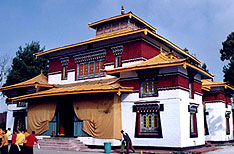 An important seat of the Nyingma order, the Enchey Monastery meaning the Solitary temple, was originally built with the solace that no other construction would be allowed near it is built on the site blessed by Lama Druptob Karpo, a tantric master known for his flying powers. This 200-year-old Monastery has in its premises images of god, goddesses and other religious objects. Every year around January 'Chaam' or religious masked dance is performed with great fanfare for two days. it is situated adjoining the Sinolchu Tourist Lodge, 3 kms from Gangtok Town. Permanent Flower Show White Hall, Close by the White Memorial Hall and just below the Palace Ridge park is the more recent Flower Show Hall. In recent years this show has become quite popular and famous as there are flower exhibitions throughout the year in accordance with the seasons and the flowers in bloom. Sa-Ngor-Chotshog CentrE It is a Tibetan refugee monastic institution established in 1961 by his Eminence Luding Khen Rimpoche, Head of Ngorpa, sub-sect of the Sakya Order, with the blessing of H.H. Sakya Trizin and H.H. the Dalai Lama. This is the only monastery of the Sakya Order of Tibetan Buddhism in Sikkim. It is located on a beautiful hill-top just 5 kms away from Gangtok Sikkim. Ganesh Tok
Tashi View Point Built by the late King of Sikkim Sri. Tashi Namgyal, it is situated 4 km from Gangtok town from where one can have a clear view of opposite hills, besides Mt. Kanchandzonga. This site offers a breathtaking panorama of the majestic Mt. Kanchandzonga and surrounding hills. Nathula 56 kms from Gangtok is a 'Nathula' Pass at an altitude of 14,200 ft. bordering between India and China in the Tibetan Plateau. It is one of the highest motorable roads and richly covered by many varities of alpine flora and fauna. A tranquil place to visit. Nathula is open only for Indian nationals on Wednesdays, Thursdays, Saturdays and Sundays. The visitors have to get the permit to visit the place by applying to the Tourism Department through a registered Travel Agency. Tsomgo Lake
Water Garden Water Garden at Martam Khola is on the 31-A National Highway some 16 kms. south of Gangtok. It is an ideal spot for picnic with a small swimming pool for children. Jawaharlal Nehru Botanical Garden Very close by to Rumtek Monastery, and maintained by the parks and Gardens unit of the Forest Department of the Government of Sikkim, the Garden is an enchanting and soothing experience among the lush green vegetation, rare plants and trees and certain species of Himalayan flowers and Orchids. Rumtek Dharma Chakra CentrE
Saramsa Garden About 14 kms from Gangtok is the Saramsa Garden, the home of Sikkim's most exotic orchids and other rare tropical and temperate plants. Established and maintained by the Department of Forest, it is an excellent recreation and picnic spot. Handloom and Handicrafts centre TIt is now known as the Directorate of Handicrafts and Handlooms as well as the Government Institute of Cottage Industries. Started during the time of the Chogyals of Sikkim, as a venture to protect and propagate the craft and skills of local and village artisans, it has become on t of the major attractions for people visiting Sikkim where traditional handcrafts, furniture, handlooms carpets and other products can be viewed and also purchased . A word of caution to the innocent guest. It is better to check whether there is a government holiday or not as the G.I.C.I. is closed on Sundays, all government declared holidays, second Saturdays and the odd unforeseen holidays. Sikkim Research Institute of Tibetology(SRIT)
Do-Drul Chorten ( Stupa) The Do-Drul Chorten or Stupa was built by the Venerable Trulshi Rimpoche, head of the Nyingma order of Tibetan Buddhism in 1945. Inside this stupa, there are complete mandala sets of Dorjee Phurba (Bajra Kilaya), a set of Kan-gyur relics ( Holy Books), complete 'Zung'( mantras) and other religious objects. Around this Chorten, which is one of the most important stupas in Sikkim, are 10 Mani-Lhakor( prayer wheels). These prayer wheels are turned by the devout Buddhist while chanting "Hail to the jewel in the Lotus", to invoke the Buddhisattva. The Chorten is surrounded by Chorten Lakhang, where there are two huge statues of Guru Rimpoche (Guru Padmasambhava). Tourist Attractions in wEST Sikkim Pemayangtse Monastery
Rabdentse Ruins This was the second capital of the erstwhile Kingdom of Sikkim after Yuksom and till the year 1814 AD, the Kings of Sikkim had ruled the State from this place. Today, the ruins lie hidden from the main road at a walking distance from the Pemayangtse Monastery. The scenic view from the top of the ruins scanning across the deep valley to the mystic heights of Khangchendzonga ranges is something to be cherished and etched in memory. Sanga-Choling Monastery This monastery is situated on a ridge above Pelling and the famous Pemayangtse Monastery. Built in 1697 AD, it is considered to be the oldest monasteries in Sikkim. In order to reach this Monastery one has to be prepared to spend at least 40 nminutes walking up the steep hilly slope which leads through rich forest covers. Khecheopalri Lake
Soreng Soreng is a picturesque village with beautiful landsacpe which is about 3 hrs. drive from pelling and 4 hrs. drive from Melli. A trek to Jhandi Danra from Soreng is a must to see the various species of flowers and birds. Hotels and lodges are available for accomodation. Varsey It lies at an elevation of 10,000 ft. and has a motorable road access upto Hilley. An easy 4 kms trek from there takes one up to the Varsey Rhododendron Sanctuary. One can also trek from Soreng or Dentam in West Sikkim. The place provides a magnificent view of the mountains. Visitors can halt at 'Guras Kunj' trekkers' hut. Tashiding Monastery
Yuksam This was the first capital of Sikkim, where according to the historical records, the first Chogyal of the Kingdom of Sikkim was consecrated in the 1641 AD by three learned lamas. The evidence of the consecration ceremony is still intact in Norbugang Chorten in the form of stone seats and a foot print of the Head Lama on the stone. Since the history of Sikkim began from this place, these areas are now considered sacred by the people of Sikkim. Yuksam is served by all weather road from Pemayangtse, which is at a distance of 32 kms from Yuksam. The trek to Dzongri and to the base camp of the famous Mt. Khangchen-Dzonga begins here. Tourist Attractions in nORTH Sikkim Guru-Dongmar Lake
Lachen Lachen is situated at an altitude of 2750 mtrs. and about 6 hrs. drive from Gangtok. The Lachen Monastery Located on top of the village commands a panoramic view of the surrounding hills and country side. Resorts, hotels and lodges are available for accomodation. Yumthang Yumthang, at an elevation of 11,800 ft and 140 kms from gangtok is a paradise for nature lovers with a fascinating blend of flora and fauna and breathtaking scenic granddeur. The valley is also the home of Singbha Rhododendron Sanctary with 24 species of Rhododendrons. Yumthang 'Tsa-Chu' or the hot spring of the left bank of Lachung Chu is immensely popular for its curative properties and healing power. Lachung
Singhik The place offers one of the most spectacular and closest views of Mt. Kanchenjunga and its ranges. A well located Tourist Lodge provides accomodation for visitors. The area also has a number of interesting short nature trails for 1 to 3 days along the higher ridges of the higher ridges of the surrounding hills. One can also savour the most graceful peak in the world, Mt. Siniolchu. Phensang Monastery This monastery is situated on the gentle slope stretching from Kabi to Phodong with perhaps one of the best landscapes in the region. The Phensang Monastery, under the Nyingmapa Buddhist Order, was built in 1721 during the time of Jigme Pawo. It was gutted by fire in 1947 and rebuilt in 1948 hrough the efforts of the lamas. The annual festival of Chaam is performed on the 29th and 29th days of the tenth month of the Lunar calendar (Tibetan Calendar). Chungthang
Phodong Monastery One of the six major monasteries in Sikkim, Phodong monastery is located in the North approximately 38 kms from Gangtok, 4 kms beyond Phodong is the recently renovated Labrang Monastery unique in it architectural design. Tourist Attractions in South Sikkim Ravangla
Borong Facing the snow-capped mountains is Borong, motorable from Ravangla or a trek via Menam. A picturesque village, its beautiful landscape and magnificent view is also host to the hot spring, Borong TsaChu'. The trek trail, originating from Namchi or Damthang to Tendong - Ravangla - Menam - Borong (5-6 days) is one of the most interesting trails scaling all the hill tops along the route. The trek can continue to Tashiding or terminate at Borong and drive back to Ravangla. Menam Hill Menam Hill towers above Tendong Hill on the other side over looking the ravangla Bazar settlement. Situated at an altitude of 10,300 ft the scenic view from this height is, perhaps, unmatched in this part of the world. Mt. Khangchendzonga and its surrounding ranges looms above the dwarf the richly forested and rugged hill. On a clear sunny day, it is possible to see the plains of Bengal spanning across Kalimpong and darjeeling Hills in the South, right across the Indo-China border towards the North. A short distance away is the legendary Bhaley Bhunga, a kind of rocky spur which juts out from the ridge top and remains suspended in the air above Yangang village. Temi Tea Garden
Namchi Namchi, meaning 'Sky High', nestled among the hills at an elevation of 5,500 ft commands panoramic view of the snow-capped mountains and vast stretches of valley. Atop Samdruptse hilltop near Namchi, recently erected is the worlds tallest statue of Guru Padmasambhava, the patron saint of both Hindus and the Buddhist. |
 It is a very small temple of Ganesh, a God worshipped by Hindus. It is on a hillock on Gangtok-Nathula Road. A Sikkim Government nursery is just nearby.
It is a very small temple of Ganesh, a God worshipped by Hindus. It is on a hillock on Gangtok-Nathula Road. A Sikkim Government nursery is just nearby.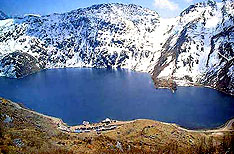 Tsomgo lake is only 40 kms. from Gangtok town and is situated at an altitude of 12,210 ft. The drive from Gangtok takes about 21 hours by bus. The lake is bout 1 km. long and oval in shape, 50ft. deep and is regarded extremely Holy. It is also a home of Brahmini ducks besides stopover for various migratory ducks.
Tsomgo lake is only 40 kms. from Gangtok town and is situated at an altitude of 12,210 ft. The drive from Gangtok takes about 21 hours by bus. The lake is bout 1 km. long and oval in shape, 50ft. deep and is regarded extremely Holy. It is also a home of Brahmini ducks besides stopover for various migratory ducks.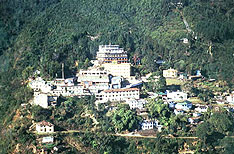 About 45 minutes drive from Gangtok, 24 kms away, is the Rumtek Dharma Chakra Centre, the seat of the Kagyu order, one of the 4 major Tibetan Buddhist sects. Since the late 1960s, after the arrival of His Holiness the 16th Gyalwa Karmapa, the Centre houses some of the world's most unique religious scriptures and religious rare objects. Traditional in design, it is almost a replica of the original Kagyurpa Monastery in Tsurphu, Tibet.
About 45 minutes drive from Gangtok, 24 kms away, is the Rumtek Dharma Chakra Centre, the seat of the Kagyu order, one of the 4 major Tibetan Buddhist sects. Since the late 1960s, after the arrival of His Holiness the 16th Gyalwa Karmapa, the Centre houses some of the world's most unique religious scriptures and religious rare objects. Traditional in design, it is almost a replica of the original Kagyurpa Monastery in Tsurphu, Tibet. 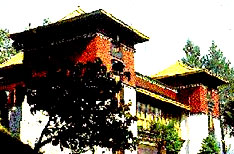 Formerly known as the Namgyal institute of Tibetology, after the late Chogyal of Sikkim, Palden Thondup Namgyal whose brainchild it was, the Sikkim Research Institute of Technology(SRIT), has since become one of the most prestigious depository of Tibetan literature, rare manuscripts, paintings, thangkas, statues and religious objects and other works of art and history. Today, it is a renowned worldwide centre for study of Buddhist philosophy and religion.
Formerly known as the Namgyal institute of Tibetology, after the late Chogyal of Sikkim, Palden Thondup Namgyal whose brainchild it was, the Sikkim Research Institute of Technology(SRIT), has since become one of the most prestigious depository of Tibetan literature, rare manuscripts, paintings, thangkas, statues and religious objects and other works of art and history. Today, it is a renowned worldwide centre for study of Buddhist philosophy and religion.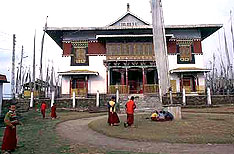 Pemayangtse Monastery is one of the oldest monasteries in the State. Orginally established by Lhatsun Chempo, one of the revered Lamas to have performed the consecration ceremony of the first Chogyal ( Religious Monarch) of Sikkim. This ancient monastery belongs to the Nyingma Buddhism and has been considered as one of the premier monasteries in the State, having been entrusted with the task to perform all religious functions of the erstwhile monarch. The Monastery, located on a hill top at an altitude of 6840 ft. commands a magnificent panoramic view of the Himalayan ranges and the surrounding hills and country-side.
Pemayangtse Monastery is one of the oldest monasteries in the State. Orginally established by Lhatsun Chempo, one of the revered Lamas to have performed the consecration ceremony of the first Chogyal ( Religious Monarch) of Sikkim. This ancient monastery belongs to the Nyingma Buddhism and has been considered as one of the premier monasteries in the State, having been entrusted with the task to perform all religious functions of the erstwhile monarch. The Monastery, located on a hill top at an altitude of 6840 ft. commands a magnificent panoramic view of the Himalayan ranges and the surrounding hills and country-side.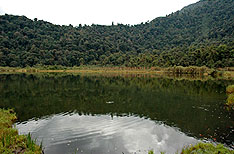 Khecheopalri Lake is considered to be one of the sacred lakes of Sikkim both by the Buddhist and the Hindus. The lake remains hidden in the rich forest cover. It is believed that birds do not permit even a single leaf to float on the lake surface. There is a motorable road from Pemayangtse right up to the lake area.
Khecheopalri Lake is considered to be one of the sacred lakes of Sikkim both by the Buddhist and the Hindus. The lake remains hidden in the rich forest cover. It is believed that birds do not permit even a single leaf to float on the lake surface. There is a motorable road from Pemayangtse right up to the lake area.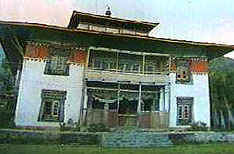 This monastery is constructed on top of a heart shaped hill with the back drop of the sacred Mt. Khang-chen-Dzonga. Acoording to Buddhist scriptures, Guru Padma Sambhava (Guru Rimpoche) blessed the sacred land of Sikkim in the 8th century AD from the spot. The monastery, however, was built in the 18th Century AD by Ngadak Sempa Chempo, one of the three lamas who had performed the consecration ceremony of the first Chogyal.
This monastery is constructed on top of a heart shaped hill with the back drop of the sacred Mt. Khang-chen-Dzonga. Acoording to Buddhist scriptures, Guru Padma Sambhava (Guru Rimpoche) blessed the sacred land of Sikkim in the 8th century AD from the spot. The monastery, however, was built in the 18th Century AD by Ngadak Sempa Chempo, one of the three lamas who had performed the consecration ceremony of the first Chogyal.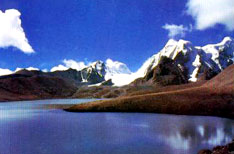 Guru-dongmar lake is considered as one of the sacred lakes of this State both by the Buddhist and the Hindus. The lake remains milky in color throughout and it is believed the Guru Padmasambhava had touched the lake whilst he visited Tibet from this area.
Guru-dongmar lake is considered as one of the sacred lakes of this State both by the Buddhist and the Hindus. The lake remains milky in color throughout and it is believed the Guru Padmasambhava had touched the lake whilst he visited Tibet from this area.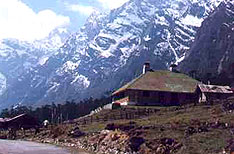 A Bhutia village with a unique loacl self-governing body called the Zumsa which substitutes the Panchayat. Lachung has emerged as a tourist destination with the soaring popularity of Yumthang Valley which is just 25 kms from Lachung. The village, spreads out on either side of Lachung Chu, has managed to retain its unique culture and tradition. The Lachung Monsatery on the slope opposite to the highway is a focal point of all religious function of the local inhabitants. To get a glimpse of the religious functions performed on auspicious occasion a visit to the Monastery should form part of the tour itinerary.
A Bhutia village with a unique loacl self-governing body called the Zumsa which substitutes the Panchayat. Lachung has emerged as a tourist destination with the soaring popularity of Yumthang Valley which is just 25 kms from Lachung. The village, spreads out on either side of Lachung Chu, has managed to retain its unique culture and tradition. The Lachung Monsatery on the slope opposite to the highway is a focal point of all religious function of the local inhabitants. To get a glimpse of the religious functions performed on auspicious occasion a visit to the Monastery should form part of the tour itinerary.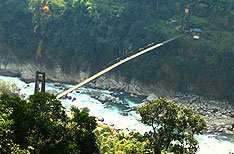 Chungtnahg, on the confluence of Lachen and Lachung Chu and the starting point of River Teesta, has emerged as a major sub-division settlement in North Sikkim. It is the nodal junction for the two passes, Lachen and Lachung. The valley is believed to have been blessed by Guru Rimpoche and one can visit the Holy Guru Lhedo to see the foot and palm prints left behind by the Patron Saint. The place is rich in bio diversity with a large variety of orchids, plants and wildlife, is 95 kms from Gangtok, 23 kms from Lachung, 29 kms from Lachen and is predominantly a Lepcha region.
Chungtnahg, on the confluence of Lachen and Lachung Chu and the starting point of River Teesta, has emerged as a major sub-division settlement in North Sikkim. It is the nodal junction for the two passes, Lachen and Lachung. The valley is believed to have been blessed by Guru Rimpoche and one can visit the Holy Guru Lhedo to see the foot and palm prints left behind by the Patron Saint. The place is rich in bio diversity with a large variety of orchids, plants and wildlife, is 95 kms from Gangtok, 23 kms from Lachung, 29 kms from Lachen and is predominantly a Lepcha region.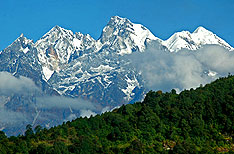 At the base of Menam Hill is Ravangla, a small township and transit to various tourist destinations in South and West Sikkim. It is also an upcoming tourist spot, and transit point for trekkers to Menam hill and Borong. There are accomodation facilities and numerous short nature trails. A trek down to the sacred cave 'Sher Chok Bephu', one of the four holiest caves in Sikkim, would be a memorable experiance.
At the base of Menam Hill is Ravangla, a small township and transit to various tourist destinations in South and West Sikkim. It is also an upcoming tourist spot, and transit point for trekkers to Menam hill and Borong. There are accomodation facilities and numerous short nature trails. A trek down to the sacred cave 'Sher Chok Bephu', one of the four holiest caves in Sikkim, would be a memorable experiance.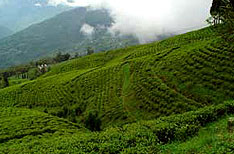 The one and only tea garden existing in the State produces one of the top quality teas in the international market. The tea garden is spread out on a gently hill slope originating from the Tendong Hill and provides a magnificent view for the surrounding villages. The visit to the factory could be an eye opener for those wanting to know more about tea processing methods.
The one and only tea garden existing in the State produces one of the top quality teas in the international market. The tea garden is spread out on a gently hill slope originating from the Tendong Hill and provides a magnificent view for the surrounding villages. The visit to the factory could be an eye opener for those wanting to know more about tea processing methods.